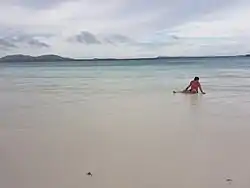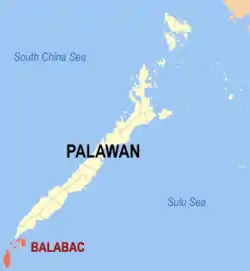Balabac, Palawan
Balabac, officially the Municipality of Balabac (Tagalog: Bayan ng Balabac), is a 2nd class municipality in the province of Palawan, Philippines. According to the 2015 census, it has a population of 40,142 people. [3]
Balabac
Tagbariri | |
|---|---|
| Municipality of Balabac | |
 Benlen Sandbar | |
 Seal | |
 Map of Palawan with Balabac highlighted | |
OpenStreetMap 
| |
.svg.png.webp) Balabac Location within the Philippines | |
| Coordinates: 7°59′N 117°03′E | |
| Country | |
| Region | Mimaropa (Region IV-B) |
| Province | Palawan |
| District | 2nd district |
| Founded | 1957 |
| Barangays | 20 (see Barangays) |
| Government | |
| • Type | Sangguniang Bayan |
| • Mayor | Shuaib J. Astami |
| • Vice Mayor | Al-Hazni A. Astami |
| • Representative | Cyrille F. Abueg-Zaldivar |
| • Electorate | 22,776 voters (2019) |
| Area | |
| • Total | 581.60 km2 (224.56 sq mi) |
| Elevation | 4.0 m (13.1 ft) |
| Highest elevation | 1,035 m (3,396 ft) |
| Lowest elevation | 0 m (0 ft) |
| Population | |
| • Total | 40,142 |
| • Density | 69/km2 (180/sq mi) |
| • Households | 8,411 |
| Economy | |
| • Income class | 2nd municipal income class |
| • Poverty incidence | 50.43% (2015)[4] |
| • Revenue | ₱143,510,962.09 (2016) |
| Service provider | |
| • Electricity | Palawan Electric Cooperative |
| Time zone | UTC+8 (PST) |
| ZIP code | 5307 |
| PSGC | |
| IDD : area code | +63 (0)48 |
| Climate type | tropical climate |
| Native languages | Molbog Kagayanen Palawano Tagalog |
The municipality consists of some 36 islands,[5] including the eponymous Balabac Island. The islands are notable for their uncommon indigenous plant and animal species, such as the nocturnal Philippine mouse-deer (or Pilandok). The islands are also home to dugongs, saltwater crocodiles, sawfishes, and sea turtles. Due to its biodiversity, the terrestrial and marine ecosystems of the Balabac archipelago are currently being pushed by scholars to be included in the tentative list of the Philippines for a possible UNESCO World Heritage Site nomination in the future.
History
Balabac was converted from a municipal district to a full municipality in 1957. Before that, it was a barrio of neighboring Bataraza.[6]
Cape Melville Lighthouse

The Cape Melville Lighthouse, located on the island of Balabac, is one of the Philippines oldest lighthouses built in 1892[7] during the Spanish era and a major landmark of the town.
Geography
Not considering the disputed Spratly Islands, the municipality is the westernmost point in the Philippines. It is separated from Sabah, Malaysia, by the Balabac Strait.
Islands
The municipality of Balabac is composed of a group of 36 major and minor islands, notable of which are the following:
|
|
Shoals and Sandbars
The municipality of Balabac is composed of various islands located at the Balabac Strait. The strait is known for its shallow waters due to the presence of shoals and numerous sandbars. Balabac has the third and fourth longest sandbars in the Philippines. The third longest is Queen Helen Sandbar at the southern tip of Bugsuk and the fourth is the Angela Sandbar east of Mansalangan.[8]
Barangays
Balabac is politically subdivided into 20 barangays:
Climate
Balabac has a tropical monsoon climate (Am) with moderate rainfall from February to May and heavy rainfall in the remaining months.
| Climate data for Balabac | |||||||||||||
|---|---|---|---|---|---|---|---|---|---|---|---|---|---|
| Month | Jan | Feb | Mar | Apr | May | Jun | Jul | Aug | Sep | Oct | Nov | Dec | Year |
| Average high °C (°F) | 28.9 (84.0) |
29.3 (84.7) |
29.8 (85.6) |
30.6 (87.1) |
30.9 (87.6) |
30.5 (86.9) |
30.1 (86.2) |
30.3 (86.5) |
29.2 (84.6) |
29.7 (85.5) |
29.5 (85.1) |
29.1 (84.4) |
29.8 (85.7) |
| Daily mean °C (°F) | 25.3 (77.5) |
25.5 (77.9) |
25.9 (78.6) |
26.5 (79.7) |
26.9 (80.4) |
26.6 (79.9) |
26.2 (79.2) |
26.3 (79.3) |
25.2 (77.4) |
26.0 (78.8) |
25.8 (78.4) |
25.6 (78.1) |
26.0 (78.8) |
| Average low °C (°F) | 21.7 (71.1) |
21.7 (71.1) |
22.0 (71.6) |
22.5 (72.5) |
23.0 (73.4) |
22.7 (72.9) |
22.3 (72.1) |
22.3 (72.1) |
21.3 (70.3) |
22.3 (72.1) |
22.2 (72.0) |
22.1 (71.8) |
22.2 (71.9) |
| Average rainfall mm (inches) | 181 (7.1) |
71 (2.8) |
80 (3.1) |
59 (2.3) |
121 (4.8) |
145 (5.7) |
140 (5.5) |
146 (5.7) |
155 (6.1) |
184 (7.2) |
260 (10.2) |
324 (12.8) |
1,866 (73.3) |
| Source: Climate-Data.org[9] | |||||||||||||
Demographics
|
| |||||||||||||||||||||||||||||||||||||||||||||
| Source: Philippine Statistics Authority [3] [10] [11][12] | ||||||||||||||||||||||||||||||||||||||||||||||
In the 2015 census, the population of Balabac was 40,142 people, [3] with a density of 69 inhabitants per square kilometre or 180 inhabitants per square mile.
Economy
| Poverty Incidence of Balabac | |
| Source: Philippine Statistics Authority[13][14][15][16][17][18] | |
Culture
The Molbog people dominate the municipality of Balabac, as well as the municipality of Bataraza in the north. The area is the homeland of the Molbog people since the classical era prior to Spanish colonization. The Molbog are known to have a strong connection with the natural world, especially with the sacred pilandok (Philippine mouse-deer), which can only be found in the Balabac islands. A Muslim tale tells the Philippine mouse-deer once tricked a prince into giving up his bag of gold and facing a hive of angry bees.[19] Another tale depicts him as a clever guardian of the environment, using his wisdom as an advantage against those who destroy forests, seas, and wildlife.[20] The coconut is especially important in Molbog culture at it is their most prized agricultural crop.[21]
Transportation
Balabac is a three-hour boat trip from Bataraza on the island of Palawan; Bataraza in turn can be reached from Palawan's capital city Puerto Princesa.
An old airstrip located on the island of Bugsuk serves no commercial flights. Another private airstrip is located on the island of Ramos.
References
- Municipality of Balabac | (DILG)
- "Province: Palawan". PSGC Interactive. Quezon City, Philippines: Philippine Statistics Authority. Retrieved 12 November 2016.
- Census of Population (2015). "Region IV-B (Mimaropa)". Total Population by Province, City, Municipality and Barangay. PSA. Retrieved 20 June 2016.
- https://psa.gov.ph/sites/default/files/City%20and%20Municipal-level%20Small%20Area%20Poverty%20Estimates_%202009%2C%202012%20and%202015_0.xlsx; publication date: 10 July 2019; publisher: Philippine Statistics Authority.
- http://www.mb.com.ph/at-the-tip-of-the-last-frontier/
- "R.A. No. 2022, An Act Converting the Municipal District of Balabac, Province of Palawan, into a Regular Municipality". LawPH.com. Archived from the original on 2012-07-10. Retrieved 2011-04-13.
- "ANC". ABS-CBN News.
- Malicdem, Ervin (12 July 2017). "10 Longest Sandbars of the Philippines". Schadow1 Expeditions. Retrieved 29 October 2017.
- "Climate: Balabac". Climate-Data.org. Retrieved 25 October 2020.
- Census of Population and Housing (2010). "Region IV-B (Mimaropa)". Total Population by Province, City, Municipality and Barangay. NSO. Retrieved 29 June 2016.
- Censuses of Population (1903–2007). "Region IV-B (Mimaropa)". Table 1. Population Enumerated in Various Censuses by Province/Highly Urbanized City: 1903 to 2007. NSO.
- "Province of Palawan". Municipality Population Data. Local Water Utilities Administration Research Division. Retrieved 17 December 2016.
- "Poverty incidence (PI):". Philippine Statistics Authority. Retrieved 28 December 2020.
- https://psa.gov.ph/sites/default/files/NSCB_LocalPovertyPhilippines_0.pdf; publication date: 29 November 2005; publisher: Philippine Statistics Authority.
- https://psa.gov.ph/sites/default/files/2003%20SAE%20of%20poverty%20%28Full%20Report%29_1.pdf; publication date: 23 March 2009; publisher: Philippine Statistics Authority.
- https://psa.gov.ph/sites/default/files/2006%20and%202009%20City%20and%20Municipal%20Level%20Poverty%20Estimates_0_1.pdf; publication date: 3 August 2012; publisher: Philippine Statistics Authority.
- https://psa.gov.ph/sites/default/files/2012%20Municipal%20and%20City%20Level%20Poverty%20Estima7tes%20Publication%20%281%29.pdf; publication date: 31 May 2016; publisher: Philippine Statistics Authority.
- https://psa.gov.ph/sites/default/files/City%20and%20Municipal-level%20Small%20Area%20Poverty%20Estimates_%202009%2C%202012%20and%202015_0.xlsx; publication date: 10 July 2019; publisher: Philippine Statistics Authority.
- "Tales of Laughter - Pilandok and the Sumusong-sa-Alongan". folklore.philsites.net. Archived from the original on 2011-07-26. Retrieved 2019-02-09.
- "Pilandok Series by Virgilio S. Almario". www.goodreads.com.
- http://ncca.gov.ph/about-culture-and-arts/culture-profile/glimpses-peoples-of-the-philippines/molbog/
External links
| Wikimedia Commons has media related to Balabac, Palawan. |